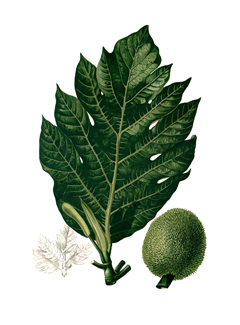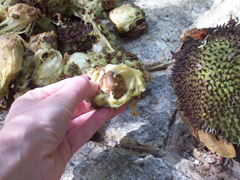 |
|
https://edibleplants.org/ |
 |
| wikimedia.org User:Bobjgalindo |
Translate this page:
Summary
Native to Papua New Guinea, Breadnut or Artocarpus camansi is a medium-sized tropical tree that can now be found in Africa, Asia, Central Africa, Congo and Costa Rica. It has a spreading crown at it can grow up to at least 10 meters tall and 100 cm in trunk diameter. It is a monoecious plant. Its fruit is globular, with about 12 to 150 seeds per fruit. The greenish-yellow fruit is usually consumed and cooked when immature - either boiled or roasted. It is nutritious and has sweet aroma and taste. The seeds can be roasted, canned, or processed into paste, butter, flour or oil. Breadnut has large leaves that can serve as soil mulch. Sticky, white, milky latex is present in all parts of the tree. The male flowers can be dried and used as mosquito repellent. The wood is light, flexible, fast burning, and can be used for fuel. Other common names include chataigne, casta?a, pana de pepita, kamansi, and kapiak. Other names: Castana, Chataigner, Kapiak, Dulugian, Kolo, Pakau, Ugod, Kelur, Kulor, Kulur, Kuror, Mei kakano, Pana de pepitas.
Physical Characteristics

 Artocarpus camansi is an evergreen Tree growing to 15 m (49ft) by 15 m (49ft) at a fast rate.
Artocarpus camansi is an evergreen Tree growing to 15 m (49ft) by 15 m (49ft) at a fast rate.
See above for USDA hardiness. It is hardy to UK zone 10. The flowers are pollinated by Bees.
Suitable for: light (sandy), medium (loamy) and heavy (clay) soils and prefers well-drained soil. Suitable pH: mildly acid, neutral and basic (mildly alkaline) soils and can grow in very alkaline soils.
It cannot grow in the shade. It prefers moist soil and can tolerate drought. The plant can tolerates strong winds but not maritime exposure.
UK Hardiness Map
US Hardiness Map
Synonyms
No synonyms are recorded for this name.
Plant Habitats
Edible Uses
Edible Parts: Fruit Oil Seed
Edible Uses: Oil
Fruit - usually cooked[ 303 ]. A sweet aroma and taste[ 303 ]. The fruits are nutritious and usually consumed when immature; thinly sliced and boiled as a vegetable in soups or stews[ 303 ]. The greenish-yellow, oval or ovoid fruit is 7 - 12cm in diameter and weighs about 800g[ 303 ]. Seed - cooked[ 303 ]. When roasted they are similar to chestnuts in texture and flavour. They can be canned in brine, or processed into nut butter or nut paste, flour, or oil[ 303 ]. The seeds are high in protein and relatively low in fat compared to nuts such as almond, Brazil nut, and macadamia nut; they are a good source of minerals and contain more niacin than most other nuts[ 303 ]. The seeds are about 25mm long, with from 12 - 150 seeds per fruit, each seed weighing 7 - 10g and, in total, comprising 30 - 50% or more of the total fruit weight[ 303 ].
References More on Edible Uses
Medicinal Uses
Plants For A Future can not take any responsibility for any adverse effects from the use of plants. Always seek advice from a professional before using a plant medicinally.
No specific medicinal uses are reported for this species, but it tree probably has medicinal properties similar to the breadfruit (Artocarpus altilis)[ 303 ].
References More on Medicinal Uses
The Bookshop: Edible Plant Books
Our Latest books on Perennial Plants For Food Forests and Permaculture Gardens in paperback or digital formats.

Edible Tropical Plants
Food Forest Plants for Hotter Conditions: 250+ Plants For Tropical Food Forests & Permaculture Gardens.
More

Edible Temperate Plants
Plants for Your Food Forest: 500 Plants for Temperate Food Forests & Permaculture Gardens.
More

More Books
PFAF have eight books available in paperback and digital formats. Browse the shop for more information.
Shop Now
Other Uses
Fuel Insecticide Latex Mulch Oil Plant support Soil stabilization Wood
Other uses rating: Medium (3/5). Agroforestry Uses: Breadnut can be interplanted with a wide range of crops and plants, such as yam, banana (Musa spp.), coconut (Cocos nucifera), sugarcane, medicinal plants, aroids, ginger, Indian mulberry (Morinda citrifolia, noni), small fruit trees, and field and vegetable crops such as corn, beans, peanut, tomato, and eggplant[ 303 ]. The large leaves of breadnut provide abundant mulch for the tree and other plants growing beneath the canopy[ 303 ]. Breadnut naturally occurs on frequently flooded river banks, where it helps to stabilize the soil[ 303 ]. The tree is planted in home gardens to provide beneficial shade to other plants. It could also be used as a trellis tree for yam (Dioscorea species)[ 303 ]. Other Uses A sticky, white, milky latex is present in all parts of the tree[ 303 ]. Dried male flowers can be burned to repel mosquitoes and other flying insects[ 303 ]. The wood is light in weight, flexible, and easy to work and carve[ 303 ] It is made into statues, bowls, fishing floats, and other objects[ 303 ]. The wood is fast burning, but generally only older, less productive trees are used for fuel[ 303 ].
Special Uses
Carbon Farming Food Forest
References More on Other Uses
Cultivation details
Management: Standard Minor Global Crop Other Systems: Homegarden Other Systems: Multistrata Staple Crop: Balanced carb
A plant of low to moderate elevations in the moist tropics, where it is found at elevations from sea level to 1,550 metres[ 303 ]. It grows best in areas where the mean maximum temperature of the hottest month is no more than 32 - 38c and the mean minimum temperature of the coolest month is no less than 16 - 18c[ 303 ]. It prefers a mean annual rainfall in the range 1,300 - 3,800mm with no distinct dry season[ 303 ]. Established plants can grow in full sun, but young plants need 20 - 50% shade[ 303 ]. Grows best in a deep, light, fertile, well drained soil[ 303 ]. Prefers a pH in the range 6.1 - 7.4[ 303 ]. Plants can tolerate waterlogged soils and also periodic inundation of the soil for brief periods[ 303 ]. Plants can withstand strong winds and will re-sprout after sustaining wind damage[ 303 ]. Once established, breadnut trees can withstand a dry season of 3 - 4 months, although they prefer moist conditions. A moderately fast growing tree[ 303 ]. Trees can start producing fruit when 8 - 10 years old[ 303 ]. The tree has a shallow-rooting system, with roots often growing along the ground[ 303 ]. Trees can produce 600-800 fruits in a season.
Carbon Farming
-
Management: Standard
Plants grow to their standard height. Harvest fruit, seeds, or other products. Non-Destructive management systems.
-
Minor Global Crop
These crops are already grown or traded around the world, but on a smaller scale than the global perennial staple and industrial crops, The annual value of a minor global crop is under $1 billion US. Examples include shea, carob, Brazil nuts and fibers such as ramie and sisal.
-
Other Systems: Homegarden
Tropical multistrata agroforestry (multi-story combinations of trees, crops, domestic animals in the homestead).
-
Other Systems: Multistrata
Multistrata agroforests feature multiple layers of trees often with herbaceous perennials, annual crops, and livestock.
-
Staple Crop: Balanced carb
(0-15 percent protein, 0-15 percent oil, with at least one over 5 percent). The carbohydrates are from either starch or sugar. Annuals include maize, wheat, rice, and potato. Perennials include chestnuts, carob, perennial fruits, nuts, cereals, pseudocereals, woody pods, and acorns.
References Carbon Farming Information and Carbon Sequestration Information
Temperature Converter
Type a value in the Celsius field to convert the value to Fahrenheit:
Fahrenheit:
The PFAF Bookshop
Plants For A Future have a number of books available in paperback and digital form. Book titles include Edible Plants, Edible Perennials, Edible Trees,Edible Shrubs, Woodland Gardening, and Temperate Food Forest Plants. Our new book is Food Forest Plants For Hotter Conditions (Tropical and Sub-Tropical).
Shop Now
Plant Propagation
Seed - it has a very short viability and needs to be sown as soon as it is ripe[ 303 ].
Other Names
If available other names are mentioned here
Breadnut or Artocarpus camansi. Other common names include chataigne, casta–a, pana de pepita, kamansi, and kapiak. Other names: Castana, Chataigner, Kapiak, Dulugian, Kolo, Pakau, Ugod, Kelur, Kulor, Kulur, Kuror, Mei kakano, Pana de pepitas.
Native Range
TROPICAL ASIA: Indonesia, Papua, Papua New Guinea, Indonesia, Maluku (possibly native),
Weed Potential
Right plant wrong place. We are currently updating this section.
Please note that a plant may be invasive in one area but may not in your area so it's worth checking.
None Known
Conservation Status
IUCN Red List of Threatened Plants Status : This taxon has not yet been assessed.

Growth: S = slow M = medium F = fast. Soil: L = light (sandy) M = medium H = heavy (clay). pH: A = acid N = neutral B = basic (alkaline). Shade: F = full shade S = semi-shade N = no shade. Moisture: D = dry M = Moist We = wet Wa = water.
Now available:
Food Forest Plants for Mediterranean Conditions
350+ Perennial Plants For Mediterranean and Drier Food Forests and Permaculture Gardens.
[Paperback and eBook]
This is the third in Plants For A Future's series of plant guides for food forests tailored to
specific climate zones. Following volumes on temperate and tropical ecosystems, this book focuses
on species suited to Mediterranean conditions—regions with hot, dry summers and cool, wet winters,
often facing the added challenge of climate change.
Read More
Expert comment
Author
Blanco
Botanical References
Links / References
For a list of references used on this page please go here
A special thanks to Ken Fern for some of the information used on this page.
Readers comment
| Add a comment |
|
If you have important information about this plant that may help other users please add a comment or link below. Only comments or links that are felt to be directly relevant to a plant will be included. If you think a comment/link or information contained on this page is inaccurate or misleading we would welcome your feedback at [email protected]. If you have questions about a plant please use the Forum on this website as we do not have the resources to answer questions ourselves.
* Please note: the comments by website users are not necessarily those held by PFAF and may give misleading or inaccurate information.
To leave a comment please Register or login here All comments need to be approved so will not appear immediately.
|
Subject : Artocarpus camansi
|
|
|
|